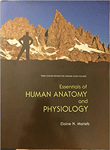
Essentials of Human Anatomy and Physiology (Custom)
15th Edition
ISBN: 9781269752862
Author: Marieb
Publisher: PEARSON
expand_more
expand_more
format_list_bulleted
Question
Chapter 12, Problem 14SAE
Summary Introduction
To review:
Function of lymph nodes.
Introduction:
The lymph nodes are the part of lymphatic system along with the lymphatic vessels and the lymphoid organs. These are the sites for lymphocyte multiplication.
Expert Solution & Answer
Want to see the full answer?
Check out a sample textbook solution
Students have asked these similar questions
Can I get a handwritten answer please. I'm having a hard time understanding this process. Thanks
Say you get AATTGGCAATTGGCAATTGGCAATTGGCAATTGGCAATTGGCAATTGGC 3ʹ and it is cleaved with Mspl restriction enzyme - how do I find how many fragments?
What is amplification bias?
Chapter 12 Solutions
Essentials of Human Anatomy and Physiology (Custom)
Ch. 12 - Prob. 1MCCh. 12 - Prob. 2MCCh. 12 - Prob. 3MCCh. 12 - Which of the following are part of MALT? a....Ch. 12 - Prob. 5MCCh. 12 - Prob. 6MCCh. 12 - Chemical mediators of inflammation include a....Ch. 12 - Against which of the following will interferon do...Ch. 12 - Prob. 9MCCh. 12 - More than one choice may apply. Which parts of an...
Ch. 12 - Which of the following antibody capabilities...Ch. 12 - Prob. 12MCCh. 12 - Prob. 13MCCh. 12 - Prob. 14SAECh. 12 - Prob. 15SAECh. 12 - Prob. 16SAECh. 12 - Prob. 17SAECh. 12 - State the role and explain the importance of MALT.Ch. 12 - Prob. 19SAECh. 12 - Prob. 20SAECh. 12 - Prob. 21SAECh. 12 - Identify the four types of acquired Immunity....Ch. 12 - Prob. 23SAECh. 12 - Prob. 24SAECh. 12 - Binding of antigens to receptors of...Ch. 12 - Prob. 26SAECh. 12 - Prob. 27SAECh. 12 - 28. Compare and contrast a primary and a secondary...Ch. 12 - Prob. 29SAECh. 12 - Prob. 30SAECh. 12 - Prob. 31SAECh. 12 - Distinguish between immediate types of allergy and...Ch. 12 - Identify the four types of tissue grafts. In...Ch. 12 - Prob. 34SAECh. 12 - Prob. 35CAQCh. 12 - Prob. 36CAQCh. 12 - Prob. 37CAQCh. 12 - Mrs. Morrow, a 59-year-old woman, has undergone a...Ch. 12 - Prob. 39CAQCh. 12 - Capillary permeability increase and plasma...
Knowledge Booster
Learn more about
Need a deep-dive on the concept behind this application? Look no further. Learn more about this topic, biology and related others by exploring similar questions and additional content below.Similar questions
- What would happen if transcriptome analysis were done on liver and muscle cells?arrow_forwardBiology How many grams of sucrose would you add to 100mL of water to make a 100 mL of 5% (w/v) sucrosesolution?arrow_forwardWhich marker does this DNA 5ʹ AATTGGCAATTGGCAATTGGCAATTGGCAATTGGCAATTGGCAATTGGC 3ʹ show?arrow_forward
- The Z value of LOD for two genes is 4, what does it mean for linkage and inheritance?arrow_forwardBiology How will you make a 50-ul reaction mixture with 2uM primer DNA using 10 uM primer DNA stocksolution and water?arrow_forwardBiology You’re going to make 1% (w/v) agarose gel in 0.5XTBE buffer 100 ml. How much agarose are you goingto add to 100 ml of buffer? The volume of agaroseis negligible.arrow_forward
- Biology How will you make a 50-ul reaction mixture with0.2 mM dNTP using 2-mM dNTP stock solution andwater?arrow_forwardBiology What is 200 pmole/uL in Molar concentration?arrow_forwardBiology How will you make a 50-ul reaction mixture with 1Xreaction buffer in it using water and 5X buffer stocksolution?arrow_forward
- Biology How would you make 200 uL of 10 pmole/uLprimer DNA solution using the 200 pmole/uLprimer DNA stock solution and distilled water?arrow_forwardBiology Now you have the 5 M of NaCl stock solution. Howwould you make one liter of 100 mM NaCl solutionusing the 5 M of NaCl solution and distilled water?arrow_forwardDevelopmental Biology Lab Question How to make one liter of 5 M NaCl stock solution?The molar weight of NaCl is 58.44 g/mol.(Molecular weight is 58.44 Dalton or amu).arrow_forward
arrow_back_ios
SEE MORE QUESTIONS
arrow_forward_ios
Recommended textbooks for you
 Biology (MindTap Course List)BiologyISBN:9781337392938Author:Eldra Solomon, Charles Martin, Diana W. Martin, Linda R. BergPublisher:Cengage Learning
Biology (MindTap Course List)BiologyISBN:9781337392938Author:Eldra Solomon, Charles Martin, Diana W. Martin, Linda R. BergPublisher:Cengage Learning Medical Terminology for Health Professions, Spira...Health & NutritionISBN:9781305634350Author:Ann Ehrlich, Carol L. Schroeder, Laura Ehrlich, Katrina A. SchroederPublisher:Cengage Learning
Medical Terminology for Health Professions, Spira...Health & NutritionISBN:9781305634350Author:Ann Ehrlich, Carol L. Schroeder, Laura Ehrlich, Katrina A. SchroederPublisher:Cengage Learning


Biology (MindTap Course List)
Biology
ISBN:9781337392938
Author:Eldra Solomon, Charles Martin, Diana W. Martin, Linda R. Berg
Publisher:Cengage Learning



Medical Terminology for Health Professions, Spira...
Health & Nutrition
ISBN:9781305634350
Author:Ann Ehrlich, Carol L. Schroeder, Laura Ehrlich, Katrina A. Schroeder
Publisher:Cengage Learning

Cell Differentiation | Genetics | Biology | FuseSchool; Author: FuseSchool - Global Education;https://www.youtube.com/watch?v=gwAz_BtVuLA;License: Standard YouTube License, CC-BY